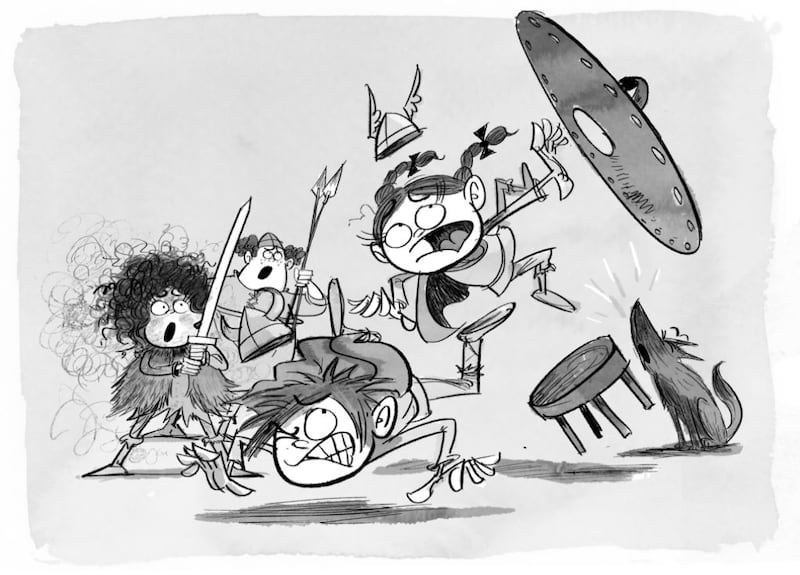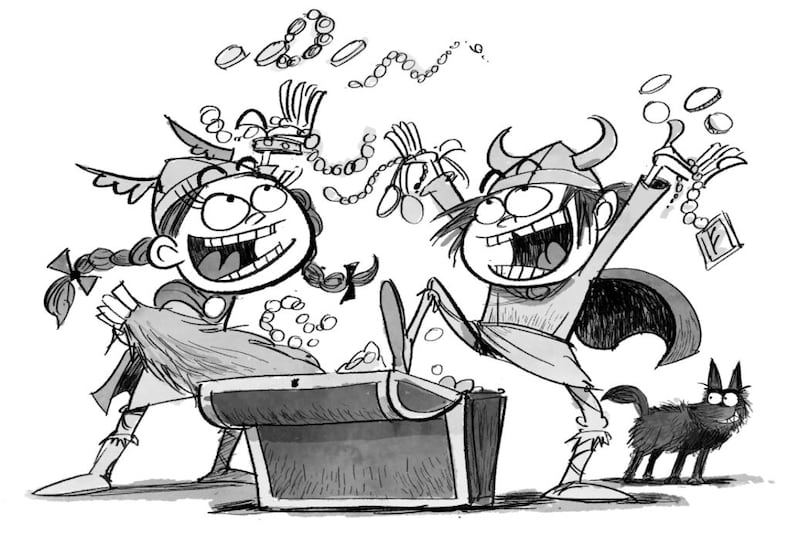I saw the children’s writer Francesca Simon at the theatre two nights before we met on Zoom. By saw, I mean virtually observed.
We were both attending Landmark Productions’ livestream of The Approach, by Mark O’Rowe, and before we turned to speaking about her enormous catalogue of children’s books, we had an invigorating discussion about the play’s mysteries, and how much we have missed live events and arts experiences during the pandemic.
Art is the reason Simon lives in a city, she tells me from her untidy office at the top of her north London house. “I love going to galleries and the theatre, being around that buzz, that stimulation. That is one of the things I found hardest about [the pandemic]: it is hard to come up with ideas when you don’t go anywhere or see anyone.”
All I did with my son, from when he was four months old, was sit around with armfuls of books from the library. I started to get ideas about stories for children myself
Still, Simon has been keeping busy, taking a live lecture series on the American Revolution at Yale, her alma mater, and going to the opera every day, courtesy of the Met in New York. The Horrid Henry writer has also just launched a new series, Two Terrible Vikings, which reinvents the idea of naughtiness that made her name.
Despite living in England since she was in her 20s, Simon still speaks with an American twang. She spent most of her childhood in California, but as her father, a writer, chased various opportunities, they moved a lot: to Paris, England, Malibu and elsewhere in her home state. Under the ever-changing circumstances, Simon developed a rich inner life and an addiction to reading.
“I read my way through the libraries, alphabetically,” she says. “I even got a job shelving books so that I could have first dibs on the books that came back in.” Her love of text was so extreme that it had physical consequences. “I would come down from my room every morning with a blue nose, and we couldn’t work out what caused it at first. It was the ink from the books!”
Even so, it was “not inevitable that I would be a writer”, she says. “I was interested in writing, but I didn’t know what I wanted to write or what I would be good at. So I thought I would be a lawyer for a long time.”
After taking a course in Old English at Yale, however, she found herself studying at Oxford, then moving to London to work as a freelance journalist. Journalism offered her the opportunity “to write about all kinds of things, and I was good at it. I had an American, easy style, but I also had academic knowledge. There wasn’t that big a divide between low- and highbrow [journalism] as there is now, and I did well for that reason.”
It was when she became a mother that she began to consider writing for children. “All I did with my son, from when he was four months old, was sit around with armfuls of books from the library. Being around all these books, I started to get ideas about stories for children myself. I never had any ambitions to write for children. But you just don’t know what you are going to be good at.”
When those first ideas, about a terror called Horrid Henry and his antagonistic relationship with his goody-two-shoes brother, were published in a four-story collection in 1994, Simon was an instant success.
Simon says it was 'hugely fun to imagine what that different world would be like, where everyone had weapons and it was okay to steal: you just called it raiding'
Despite being the catalyst for her new career, Simon’s son was emphatically not the inspiration for Horrid Henry. Indeed, for that she turned back to her own childhood.
For, despite appearances, Simon was “quite a divided soul. I was an incredibly perfect child at school,” she says. “I always did my homework and had my hand up. I loved being at school. But at home I was quite an angry and aggressive child. I was the oldest of four, and I remember desperately wanting to be an only child: I was very much an ‘Out of my way, worm’ kind of sister. One thing I really remember is feeling very powerless and how I used to fantasise in an ‘If I was emperor for a day’ kind of way.”
When it came to writing for children, she began thinking about “the inherent comedy of family life, of disparate people trapped together. Father Ted is a perfect example: these very different people trapped on an island; the situation is just naturally very funny. So I thought about how that type of comedy might work in a family, where the parents choose each other but the parents don’t choose the children and the siblings don’t choose each other, so you have a perfect opportunity for a clash.”
Horrid Henry is built on the idea of that opposition. Henry’s arch-nemesis is his younger brother, Perfect Peter, who is as angelic as Henry is demonic. “It is sort of like Cain and Abel: an unending fight to the death over something as stupid as who has the remote control,” says Simon. “Henry is an outlaw playing sibling rivalry for laughs, and there was a great freedom in writing about someone who wasn’t thinking of consequences.”

With the Horrid Henry books, however, Simon felt somewhat limited by the realist context. As a child, her own favourite stories came from the canon of myth and fairy tale, where anything can and frequently does happen. Indeed, it was her attraction to those ancient and timeless tales that had determined the course of her life, when she chose to study medieval languages at university.
Eventually, Simon began to think about using all that deep knowledge in her own work, and eventually published several books that took their inspiration from the ancient world.
The Sleeping Army (2011), inspired by the Lewis Chessmen at the British Museum, and The Lost Gods (2013) were contemporary middle-grade adventures in which the Viking gods still rule in the modern day, while The Monstrous Child (2016) – “favourite book ever” – saw Simon turn her attention to young adult readers for the first time, crafting an epic story in which Hel, Norse goddess of the underworld, gets to tell her own story.
Two Terrible Vikings brings together Simon’s interest in the Norse sagas and her talent for entertaining younger readers. It began with Simon wondering what it might have been like to have Viking parents. “Imagine!” she says with childlike glee.
“They would want you to be ferocious and rude and steal boats and certainly wouldn’t want you to share. No one would be saying, ‘Oh my God, why are they not being cared for’? They are Vikings: that’s what they do!”

Simon says it was “hugely fun to imagine what that different world would be like, where everyone had weapons and it was okay to steal: you just called it raiding”. The book was due to be published last year but was postponed because of coronavirus. Despite the disappointment of the delay, Simon admits that she is “lucky to be so established in my career, because I can only imagine how dreadful [the effects of the pandemic on publishing] have been for anyone trying to get started, with everything postponed or happening on Zoom. It almost feels like 2020 didn’t happen at all.”
More profound than postponement, however, was the loss of interaction with children and parents at schools and festivals that is so crucial to Simon’s process. “As a writer,” she explains, “you would normally go to loads of festivals and read aloud before publishing a new book so you would get a sense of the audiences’ responses. You would read a story aloud in schools and you would notice different things – what works, what doesn’t.”
Now that the book is out in the world, though, Simon is privy to what young readers are enjoying, which is perfect timing, really, as she is hard at work on a sequel and she now knows what it needs: "More bragging, more dirt, more boasting and absolutely no sharing."
Two Terrible Vikings, illustrated by Steve May, is published by Faber & Faber



















